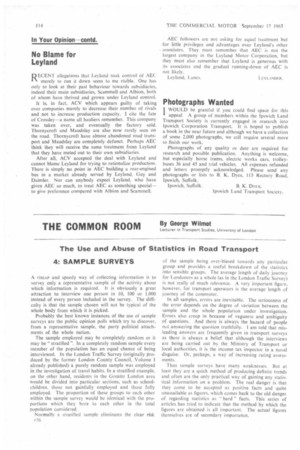THE COMMON ROOM
Page 114

If you've noticed an error in this article please click here to report it so we can fix it.
By George Wilmot
Lecturer in Transport Studies, University of London
The Use and Abuse of Statistics in Road Transport 4: SAMPLE SURVEYS
A CHEAP and speedy way of collecting information is to survey only a representative sample of the activity about which information is required. It is obviously a great attraction to interview one person in 10, 100 or 1.000 instead of every person included in the survey. The difficulty is that the sample chosen will not be typical of the whole body from which it is picked.
Probably the best known instances of the use of sample surveys are the public opinion polls which try to discover, from a representative sample, the party political attachments of the whole nation.
The sample employed may be completely random or it may be "stratified ". In a completely random sample every member of the population has an equal chance of being interviewed. In the London Traffic Survey (originally tiroduced by the former London County Council, ,Volume already published) a purely random sample was employed in the investigation of travel habits. In a stratified example, on the other hand, residents in the Greater London area would be divided into particular sections, such as schoolchildren, those not gainfully employed and those fully employed. The proportion of these groups to each other within the sample survey would be identical with the proportions which they bore to each other in the total population considered.
Normally, a stratified sample eliminates the clear risk c36 of the sample being over-biased towards any particular group and provides a useful breakdown of the statistics into sensible groups. The average length of daily journey for Londoners as a whole (as in the London Traffic Survey) is not really of much relevance. A very important figure, however, for transport operators is the average length of journey of the commuter.
In all samples, errors are inevitable. The seriousness of the error depends on the degree of variation between the sample and the whole population under investigation. Errors also creep in because of vaguness and ambiguity of questions. And there is always the hazard of people not answering the question truthfully. I am told that misleading answers are frequently given in transport surveys as there is always a belief that although the interviews are being carried out by the Ministry of Transport or local authorities, it is the income tax inspector in a novel disguise. Or, perhaps, a way of increasing rating assessments.
Thus sample surveys have many weaknesses. But at least they are a quick method of producing definite trends and often are the only practical way of gaining any statistical information on a problem. The real danger is that they come to be accepted as positive facts and quite unassailable as figures, which comes back to the old danger of regarding statistics as " hard " facts. This series of articles has tried to indicate that the method by which the figures are obtained is all important The actual figures themselves are of secondary importance.




















































































































































































